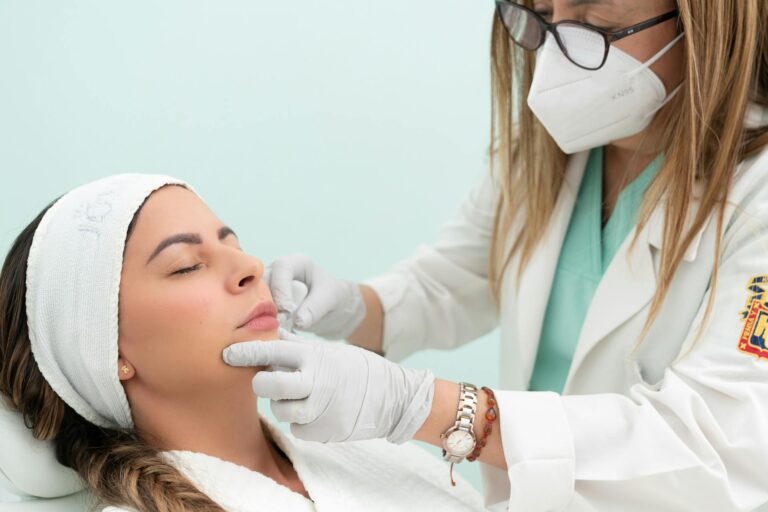
Botox has emerged as a well-known option in the realm of cosmetic treatments, celebrated for its effectiveness in reducing wrinkles and enhancing facial features. But can Botox lift eyebrows? Many individuals seek this treatment for its ability to provide a subtle, youthful lift to the brows, enhancing their overall facial appearance.
This article delves into the effectiveness of Botox for eyebrow lifting, examines potential risks, and outlines what one can expect from the treatment. If you are contemplating Botox for a youthful enhancement, continue reading to uncover all the essential information you need.
What is Botox?

Botox has become a widely recognised non-surgical procedure in cosmetic treatments, aiming to enhance facial aesthetics by reducing the appearance of dynamic wrinkles and promoting facial symmetry. This injectable treatment, derived from a neurotoxin, functions by temporarily relaxing facial muscles, which effectively diminishes the visibility of wrinkles and fine lines. As a result, it has become a preferred option among patients in the UK seeking effective anti-ageing solutions.
Originally derived from the botulinum toxin, Botox has come a long way since its medical introduction in the late 1980s, when it was primarily used for various muscle-related conditions before making its mark in the aesthetic field.
Aesthetic clinics typically administer this treatment with a high level of precision, targeting areas such as the forehead, crow’s feet, and frown lines. Patients often appreciate the swift nature of the procedure, which generally takes less than 30 minutes, allowing them to seamlessly return to their daily activities with minimal downtime.
The increasing popularity of Botox in the UK can be largely attributed to high patient satisfaction rates. Many individuals report experiencing immediate improvements with results that are both subtle and noticeable.
It is essential to emphasise the significance of practitioner qualifications; certified professionals play a crucial role in ensuring the safety and effectiveness of the treatment.
How Does Botox Work?
Botox functions by using a neurotoxin that comes from the bacterium Clostridium botulinum. This neurotoxin acts as a muscle relaxant, temporarily paralyzing specific facial muscles.
This advanced injection technique effectively reduces the muscle movements that contribute to the formation of wrinkles, resulting in smoother skin and enhanced facial features. Additionally, it can aid in collagen production and improve overall skin elasticity.
What Are the Benefits of Botox?
Botox presents numerous advantages that position it as a top choice for cosmetic treatments among patients in the UK, particularly in facial aesthetics.
This non-invasive procedure effectively reduces wrinkles, revitalises skin texture, and improves facial balance.
As a result, individuals can attain their aesthetic goals with minimal downtime, and the temporary effects often lead to a significant boost in patient satisfaction.
1. Reduces Wrinkles and Fine Lines
One of the most widely recognised advantages of Botox is its effectiveness in reducing both dynamic and static wrinkles, leading to a smoother complexion and enhanced facial expressions. By temporarily relaxing the muscles responsible for these wrinkles, individuals can achieve a more youthful appearance without resorting to invasive plastic surgery.
Dynamic wrinkles, primarily caused by repetitive facial movements such as frowning or squinting, can be notably diminished through Botox treatments. In contrast to static wrinkles, which remain visible regardless of movement and often necessitate alternative solutions such as fillers or laser therapy, Botox directly addresses the underlying causes of these expression lines.
For optimal results, individuals typically undergo treatments every three to six months, tailored to their specific needs and the severity of their wrinkles. Many discover that with regular sessions, the effects become more pronounced, contributing to a sustained improvement in their overall appearance and confidence.
2. Lifts Eyebrows
Botox can be utilised to achieve a subtle eyebrow lift, enhancing the position of the brows and contributing to the overall balance of the face. This technique, often referred to as the Botox eyebrow lift, helps open up the eyes and provides a more youthful and refreshed appearance without resorting to surgical options.
By strategically injecting small amounts of Botox into specific muscles around the forehead and brow, practitioners can create a customised brow elevation that aligns with each patient’s unique facial structure and aesthetic preferences. Factors such as age, gender, and individual facial features are crucial in determining the optimal dosage and injection sites, ensuring a naturally lifted appearance.
This non-invasive approach not only smooths out fine lines but also enhances the arch of the eyebrows, providing a harmonious frame for the eyes and accentuating attractive facial contours. Such personalised adjustments enable individuals to achieve their aesthetic goals while maintaining a refreshed yet natural look.
3. Treats Excessive Sweating
Plus its cosmetic uses, Botox proves to be effective in treating excessive sweating, a condition known as hyperhidrosis. This makes it a versatile, non-invasive treatment option for a variety of patient demographics.
By blocking the nerve signals that stimulate sweat glands, Botox provides long-lasting relief and significantly enhances the quality of life for those who struggle with this issue.
Treatment typically targets areas such as the armpits, palms, feet, and even the face, allowing individuals to regain their comfort in both personal and professional environments. The procedure itself is relatively quick, usually taking about 15 to 30 minutes, which allows patients to easily incorporate it into their busy schedules. Most individuals begin to notice a reduction in sweating within a few days, with results lasting anywhere from several months to a year.
It is important for patients to be aware of the potential risks and side effects, which may include temporary muscle weakness and localised pain.
Many individuals have shared transformative experiences, emphasizing how effective the treatment has been in enabling them to participate in social activities without the fear of embarrassment caused by excessive sweating.
What are the Risks and Side Effects of Botox?

Botox is widely regarded as safe for aesthetic procedures; however, it is important for UK patients to be aware of the potential risks and side effects associated with its use before undergoing treatment.
Understanding these factors is vital for ensuring patient safety and making informed choices. Therefore, consultations with qualified medical professionals are essential in this process.
1. Bruising and Swelling
Bruising and swelling are common side effects that many individuals experience after Botox injections. These reactions often arise from the injection technique used during the procedure. By understanding these short-term effects, patients can better manage their expectations and enjoy a smoother recovery process.
It is important for patients to realise that these reactions are a natural response of the body to the minor trauma caused by the needles used for the treatment. Several factors can influence the severity of bruising and swelling, including individual skin sensitivity, the specific area being treated, and the volume of product injected.
To minimise these unwanted effects, patients are encouraged to apply ice packs both before and after the procedure. It is also advisable to avoid blood-thinning medications and refrain from alcohol consumption for a few days following the treatment.
Following aftercare instructions is crucial, as it not only helps reduce discomfort but also enables patients to take control of their healing process, ultimately leading to the desired aesthetic results.
2. Headache and Flu-like Symptoms
Some patients may experience headaches or flu-like symptoms after undergoing Botox treatment, which can understandably be a concerning side effect. Recognising these symptoms as potential reactions to the neurotoxin can help patients manage their expectations during the recovery process.
While these side effects are generally mild and temporary, their duration can vary, lasting anywhere from a few hours to several days. It is important for individuals undergoing such treatments to be aware of these possible reactions and to monitor their condition closely.
Patient awareness is crucial; timely communication with healthcare practitioners about any unusual or persistent symptoms can lead to more effective management strategies. Understanding that such effects can arise allows for a more informed and less anxious recovery, highlighting the importance of staying engaged with one’s health provider during this time.
3. Drooping Eyelids
Drooping eyelids, commonly referred to as ptosis, can sometimes occur following Botox injections, particularly when the neurotoxin diffuses beyond the intended treatment areas. This side effect highlights the necessity of understanding muscle dynamics and the precision required in injection techniques.
Plus improper injection techniques, drooping eyelids may also be a result of underlying conditions, such as age-related muscle weakening or nerve issues. The duration of this side effect can vary significantly; it might resolve within a few hours or take several weeks, depending on individual circumstances and the severity of the case.
If someone experiences drooping eyelids, it is important to promptly consult with a qualified healthcare provider for effective management. Choosing an experienced practitioner is vital, as they are more likely to minimise the risks associated with Botox, ensuring both optimal results and the patient’s safety and comfort throughout the treatment process.
4. Allergic Reactions
Whilst allergic reactions to Botox are quite rare, they can occur and may lead to serious complications. This reality underscores the importance of thorough patient screening and safety measures. Both practitioners and patients should understand the potential for such reactions to ensure a positive treatment experience.
Being able to recognise the signs of an allergic reaction—such as rash, itching, or swelling—can significantly aid in providing preemptive care. It is essential for practitioners to take a comprehensive medical history from the patient, paying close attention to any past reactions to medications or cosmetic treatments. This step is crucial in assessing individual susceptibility.
Through detailed pre-treatment consultations, healthcare providers can effectively identify patients who may be at higher risk, thereby fostering a safer environment for everyone involved. This careful selection process ultimately enhances both the satisfaction and safety of Botox treatments, allowing patients to enjoy the results with minimal concern.
How Long Do Botox Results Last?

The results of Botox generally last between three and six months, influenced by various individual factors such as skin type, the area being treated, and the dosage administered.
It is important for patients to understand the temporary nature of Botox effects, as this understanding will help them plan for maintenance treatments to achieve lasting aesthetic results.
1. Initial Results
Initial results from Botox treatments can typically be noticed within a few days after the procedure, with the most optimal effects usually becoming apparent within one to two weeks. It is important to manage patient expectations during this time to ensure satisfaction with the aesthetic outcomes.
In the first few days following treatment, patients may experience mild swelling or bruising at the injection sites. This is entirely normal and should resolve quickly. The procedure itself is relatively short, usually lasting about 15 to 30 minutes, making it easy to fit into even the busiest of schedules.
Having follow-up consultations is crucial for individuals, as these appointments not only allow for monitoring of the initial results but also provide an opportunity to make any necessary adjustments to achieve the desired appearance. These follow-ups foster open communication regarding any concerns or questions, ensuring that the overall aesthetic experience is both satisfactory and effective.
2. Maintenance Treatments
Maintenance treatments for Botox play a crucial role in sustaining the desired results. Many patients find that scheduling follow-up sessions every three to six months helps them maintain a youthful appearance. This regularity allows individuals to enjoy long-lasting effects while remaining aligned with their aesthetic aspirations.
Consistent appointments not only enhance the initial outcomes but also promote a commitment to personal care, which is essential for preserving skin elasticity and vibrancy over time. Integrating regular maintenance can significantly affect the overall aesthetic result, enabling the skin to evolve gracefully and reducing the prominence of wrinkles and fine lines.
Patients frequently express higher levels of satisfaction, as these ongoing treatments bolster the youthful radiance they seek, thereby enhancing self-confidence that positively influences various aspects of their lives.
Ultimately, establishing a routine with maintenance treatments is vital for achieving and retaining that coveted appearance for years to come.
Can Botox Lift Eyebrows?
Indeed, Botox can effectively lift the eyebrows, resulting in a more youthful brow position and improving overall facial aesthetics. For those wondering how often one can Botox their eyebrows, treatments are typically recommended every three to four months to maintain the desired lift and achieve consistent results.
This innovative application of Botox has gained popularity as a non-invasive alternative to traditional surgical brow lifts, offering patients appealing outcomes without the lengthy recovery time associated with surgery.
1. How Does Botox Lift Eyebrows?
Botox enhances the appearance of the eyebrows by specifically targeting the muscles responsible for brow positioning through precise injection techniques. By temporarily relaxing these muscles, Botox enables other muscles to take over, resulting in a lifted appearance and improved brow aesthetics.
A thorough understanding of forehead anatomy is essential, as the interaction between the frontalis, corrugator, and procerus muscles plays a significant role in determining the shape and height of the brows. When injections are administered with expertise, they effectively soften the muscles that tend to pull the brows down, while allowing the muscles that elevate the brows to have a greater influence.
The experience of the practitioner greatly affects the results. A skilled injector not only has a trained eye for aesthetic balance but also understands the exact techniques required to create a harmonious look. This expertise helps to minimise potential complications and ultimately enhances patient satisfaction.
2. Who is a Good Candidate for Botox Eyebrow Lift?
Good candidates for a Botox eyebrow lift are generally those looking to enhance their brow position and achieve a more youthful appearance without the need for surgery. Typically, ideal candidates include individuals experiencing dynamic wrinkles or sagging skin around the brow area, provided they have realistic aesthetic goals.
Suitable candidates usually fall within a specific age range, often beginning in their late 20s and extending to their early 60s, as this is when signs of ageing tend to become more noticeable. Furthermore, having a particular skin type can be beneficial; individuals with good skin elasticity often respond more favourably to the treatment.
It is important for individuals with specific medical histories, such as neuromuscular disorders or those taking certain medications, to approach the procedure with caution. Consequently, thorough consultations are essential; they allow potential candidates to discuss their unique situations, evaluate their suitability, and gain a clearer understanding of what the procedure entails.
What is the Cost of Botox Eyebrow Lift in the UK?

The cost of a Botox eyebrow lift in the UK can vary significantly based on several factors, including the practitioner’s qualifications, the location of the aesthetic clinic, and the quantity of product used during the treatment. It is important for patients in the UK to understand these variables when budgeting for this popular cosmetic procedure.
Patients should note that prices can differ considerably between metropolitan areas and smaller towns, reflecting local economic conditions and demand. In more competitive urban centres, practitioners may offer promotional rates to attract a larger clientele, while regions with fewer clinics might charge higher prices.
The background and experience of the practitioner are also crucial in determining the overall cost; those with advanced credentials and extensive experience often command higher fees for their services.
Additionally, younger demographics, particularly millennials and Generation Z, are increasingly willing to invest in aesthetic treatments, indicating that the market for these procedures is on the rise.
Prospective patients must carefully consider these factors to strike a balance between affordability and the quality of care they receive.
How to Choose a Qualified Botox Provider in the UK?
Selecting a qualified Botox provider in the UK is an essential step to ensure patient safety and achieve the best possible aesthetic results. It is important to thoroughly research the qualifications, experience, and patient-centred approach of practitioners within the competitive aesthetic industry.
When evaluating a provider, you should look for credentials such as medical training and certifications specifically related to aesthetic procedures. Experience is also a critical factor; therefore, it is advisable to ask how many treatments the practitioner has performed and which techniques they are familiar with.
Patient testimonials and reviews can offer valuable insights into the practitioner’s skills and demeanour, illuminating the overall patient experience. Scheduling a consultation is a crucial step, as it allows for the discussion of expectations, the opportunity to ask questions, and the chance to assess your comfort level with the practitioner.
Ultimately, feeling comfortable with your provider is vital, as it builds the trust and confidence necessary for a successful treatment process.
Frequently Asked Questions
Can Botox lift eyebrows?
Yes, Botox can be used to lift eyebrows. It works by relaxing the muscles that pull eyebrows down, allowing the muscles that lift the eyebrows to work more effectively.
How long does a Botox eyebrow lift last?
The effects of a Botox eyebrow lift typically last 3-4 months. However, results may vary depending on the individual’s metabolism, lifestyle, and dosage used.
Is Botox safe for lifting eyebrows?
Botox is generally considered safe for eyebrow lifting when administered by a qualified and experienced medical professional. However, as with any medical procedure, there are risks involved, so it is important to consult with your doctor and discuss any potential concerns.
Can Botox lift eyebrows without surgery?
Yes, Botox is a non-surgical option for lifting eyebrows. It is a minimally-invasive procedure that involves a few small injections into the muscles of the forehead and eyebrows, resulting in a more lifted and youthful appearance.
Are there any side effects of Botox eyebrow lift?
Like any medical procedure, Botox eyebrow lift may have some side effects. These can include temporary redness, bruising, or swelling at the injection site. Rarely, more serious side effects such as headaches, nausea, or drooping of the eyelid may occur. It is important to discuss any potential risks with your doctor before undergoing the procedure.
How much does a Botox eyebrow lift cost in the UK?
The cost of a Botox eyebrow lift in the UK can vary depending on the location, clinic, and amount of Botox used. On average, the cost can range from £150-£400 per treatment session. It is best to consult with your doctor for an accurate price estimate.






